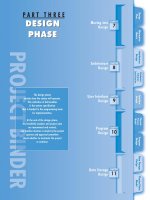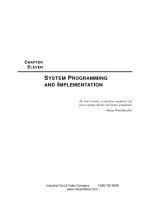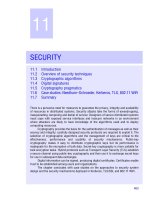Ebook Organization theory and design (9th edition): Part 1
Bạn đang xem bản rút gọn của tài liệu. Xem và tải ngay bản đầy đủ của tài liệu tại đây (8.95 MB, 263 trang )
Organization Theory and Design
NINTH EDITION
Richard L. Daft
VA N D E R B I LT U N I V E R S I T Y
Organization Theory and Design, Ninth Edition
Richard L. Daft
With the Assistance of Patricia G. Lane
Vice President/Editorial Director:
Jack W. Calhoun
Senior Production Project Manager:
Cliff Kallemeyn
Photo Editor:
Deanna Ettinger
Vice President/Editor-in-Chief:
Dave Shaut
Technology Project Editor:
Kristen Meere
Production House:
Graphic World Inc.
Senior Acquisitions Editor:
Joe Sabatino
Web Coordinator:
Karen Schaffer
Senior Developmental Editor:
Emma F. Guttler
Art Director:
Tippy McIntosh
Printer:
RR Donnelley
Willard, OH
Marketing Manager:
Kimberly Kanakas
Senior Manufacturing Coordinator:
Doug Wilke
COPYRIGHT © 2007
Thomson South-Western, a part of The
Thomson Corporation. Thomson, the Star
logo, and South-Western are trademarks
used herein under license.
ALL RIGHTS RESERVED.
Library of Congress Control Number:
No part of this work covered by the copyright hereon may be reproduced or used
in any form or by any means—graphic,
electronic, or mechanical, including photocopying, recording, taping, Web distribution or information storage and retrieval systems, or in any other
manner—without the written permission
of the publisher.
2005937447
Printed in the United States of America
1 2 3 4 5 08 07 06 05
Student Edition ISBN 0-324-40542-1
Instructor Edition ISBN 0-324-42272-5
For permission to use material from this
text or product, submit a request online at
.
For more information about our products,
contact us at:
Thomson Learning Academic Resource
Center
1-800-423-0563
Thomson Higher Education
5191 Natorp Boulevard
Mason, OH 45040
USA
About the Author
Richard L. Daft, Ph.D., is the Brownlee O. Currey, Jr., Professor of Management in
the Owen Graduate School of Management at Vanderbilt University. Professor Daft
specializes in the study of organization theory and leadership. Professor Daft is a
Fellow of the Academy of Management and has served on the editorial boards of
Academy of Management Journal, Administrative Science Quarterly, and Journal
of Management Education. He was the Associate Editor-in-Chief of Organization
Science and served for three years as associate editor of Administrative Science
Quarterly.
Professor Daft has authored or co-authored 12 books, including Management
(Thomson Learning/South-Western, 2005), The Leadership Experience (Thomson
Learning/South-Western, 2005), and What to Study: Generating and Developing
Research Questions (Sage, 1982). He recently published Fusion Leadership: Unlocking the Subtle Forces That Change People and Organizations (Berrett-Koehler,
2000, with Robert Lengel). He has also authored dozens of scholarly articles,
papers, and chapters. His work has been published in Administrative Science Quarterly, Academy of Management Journal, Academy of Management Review, Strategic
Management Journal, Journal of Management, Accounting Organizations and
Society, Management Science, MIS Quarterly, California Management Review, and
Organizational Behavior Teaching Review. Professor Daft has been awarded several
government research grants to pursue studies of organization design, organizational
innovation and change, strategy implementation, and organizational information
processing.
Professor Daft is also an active teacher and consultant. He has taught management, leadership, organizational change, organizational theory, and organizational
behavior. He has been involved in management development and consulting for
many companies and government organizations, including the American Banking
Association, Bell Canada, National Transportation Research Board, NL Baroid,
Nortel, TVA, Pratt & Whitney, State Farm Insurance, Tenneco, the United States Air
Force, the United States Army, J. C. Bradford & Co., Central Parking System,
Entergy Sales and Service, Bristol-Myers Squibb, First American National Bank, and
the Vanderbilt University Medical Center.
iii
This page intentionally left blank
Brief Contents
Preface
xv
Part 1: Introduction to Organizations
1. Organizations and Organization Theory
1
2
Part 2: Organizational Purpose and Structural Design
2. Strategy, Organization Design, and Effectiveness
3. Fundamentals of Organization Structure 88
53
54
Part 3: Open System Design Elements
4. The External Environment 136
5. Interorganizational Relationships 170
6. Designing Organizations for the International Environment
135
204
Part 4: Internal Design Elements
243
7. Manufacturing and Service Technologies 244
8. Information Technology and Control 286
9. Organization Size, Life Cycle, and Decline 319
Part 5: Managing Dynamic Processes
10.
11.
12.
13.
Organizational Culture and Ethical Values
Innovation and Change 398
Decision-Making Processes 441
Conflict, Power, and Politics 481
357
358
Integrative Cases
1.0
2.0
3.0
4.0
5.0
6.0
7.0
8.1
8.2
517
It Isn’t So Simple: Infrastructure Change at Royce Consulting 518
Custom Chip, Inc. 522
W. L. Gore & Associates, Inc. Entering 1998 528
XEL Communications, Inc. (C): Forming a Strategic Partnership 543
Empire Plastics 549
The Audubon Zoo, 1993 552
Moss Adams, LLP 566
Littleton Manufacturing (A) 577
Littleton Manufacturing (B) 589
Glossary 591
Name Index 601
Corporate Name Index
Subject Index 614
610
v
This page intentionally left blank
Contents
Preface
xv
Part 1: Introduction to Organizations
1
Chapter 1: Organizations
and Organization Theory
2
A Look Inside: Xerox Corporation
3
In Practice: Federal Bureau of Investigation
24
Organization Theory in Action
6
The Evolution of Organization Theory and Design
25
7
Historical Perspectives, 25 • Contemporary
Organization Design, 27 • Efficient
Performance versus the Learning
Organization, 28
In Practice: W. L. Gore & Associates
Topics, 6 • Current Challenges, 6
Leading by Design: The Rolling Stones
Purpose of This Chapter, 10
What Is an Organization?
10
Definition, 10 • Types of Organizations, 11
• Importance of Organizations, 12
Book Mark 1.0: The Company: A Short History of a
Revolutionary Idea
12
Perspectives on Organizations
14
Open Systems, 14 • Organizational
Configuration, 16
Dimensions of Organization Design
17
Structural Dimensions, 17 • Contextual
Dimensions, 20
In Practice: Cementos Mexicanos
32
Framework for the Book
33
Levels of Analysis, 33 • Plan of the Book,
34 • Plan of Each Chapter, 36
Summary and Interpretation
Chapter 1 Workbook: Measuring Dimensions
of Organizations
Case for Analysis: Perdue Farms Inc.:
Responding to 21st Century Challenges
Part 2: Organizational Purpose and Structural Design
Chapter 2: Strategy, Organization
Design, and Effectiveness
A Look Inside: Starbucks Corporation
Leading by Design: Wegmans
54
55
Purpose of This Chapter, 56
21
Performance and Effectiveness Outcomes, 22
36
38
39
53
61
The Importance of Goals, 62
A Framework for Selecting Strategy and Design
62
Porter’s Competitive Strategies, 63
The Role of Strategic Direction in Organization
Design
56
Organizational Purpose
58
In Practice: Ryanair
64
Miles and Snow’s Strategy Typology, 65
Mission, 58 • Operative Goals, 59
vii
viii
Contents
Book Mark 2.0: What Really Works:
The 4 ϩ 2 Formula for Sustained Business Success
66
How Strategies Affect Organization
Design, 67 • Other Factors Affecting
Organization Design, 69
Functional, Divisional, and Geographical Designs
70
Contingency Effectiveness Approaches
70
Goal Approach, 71
72
Resource-based Approach, 73 • Internal
Process Approach, 74
In Practice: The Thomson Corporation
78
Summary and Interpretation
79
Chapter 2 Workshop: Competing Values
and Organizational Effectiveness
Chapter 3: Fundamentals
of Organization Structure
A Look Inside: Ford Motor Company
80
81
84
85
In Practice: Microsoft
106
88
89
90
Information-Processing Perspective on Structure
91
108
Conditions for the Matrix, 109 • Strengths
and Weaknesses, 110
In Practice: Englander Steel
111
Horizontal Structure
113
Characteristics, 114
In Practice: GE Salisbury
115
Strengths and Weaknesses, 116
117
How the Structure Works, 117
In Practice: TiVo Inc.
Organization Structure
118
Strengths and Weaknesses, 118
Hybrid Structure
120
Applications of Structural Design
122
Structural Alignment, 122 • Symptoms of
Structural Deficiency, 123
Summary and Interpretation
124
92
Chapter 3 Workbook: You and Organization
Structure
126
94
Case for Analysis: C & C Grocery Stores, Inc.
Case for Analysis: Aquarius Advertising Agency
Vertical Information Linkages, 93
In Practice: Oracle Corporation
Functional Structure with Horizontal
Linkages, 104 • Divisional Structure, 104
Virtual Network Structure
Purpose of This Chapter, 90
Book Mark 3.0: The Future of Work: How the New
Order of Business Will Shape Your Organization, Your
Management Style, and Your Life
103
Geographical Structure, 107
75
Case for Analysis: The University Art Museum
Case for Analysis: Airstar, Inc.
In Practice: Blue Bell Creameries, Inc.
Matrix Structure
An Integrated Effectiveness Model
Chapter 2 Workbook: Identifying Company Goals
and Strategies
102
Functional Structure, 102
Assessing Organizational Effectiveness
In Practice: Chevrolet
Required Work Activities, 99 • Reporting
Relationships, 100 • Departmental
Grouping Options, 100
126
129
Horizontal Information Linkages, 95
Organization Design Alternatives
99
Part 3: Open System Design Elements
Chapter 4: The External Environment
A Look Inside: Nokia
136
137
Purpose of This Chapter, 138
The Environmental Domain
138
Task Environment, 138 • General
Environment, 140 • International
Context, 141
In Practice: Ogilvy & Mather
viii
135
Environmental Uncertainty
142
Simple–Complex Dimension, 143 •
Stable–Unstable Dimension, 144
Book Mark 4.0: Confronting Reality: Doing What Matters
to Get Things Right
144
Framework, 145
Adapting to Environmental Uncertainty
142
Positions and Departments, 147 • Buffering
and Boundary Spanning, 147
147
Contents
In Practice: Genesco
ix
149
Differentiation and Integration, 149 •
Organic versus Mechanistic Management
Processes, 151 • Planning, Forecasting, and
Responsiveness, 152
Leading by Design: Rowe Furniture Company
153
Framework for Organizational Responses
to Uncertainty
Resource Dependence
Controlling Environmental Resources
154
Case for Analysis: Oxford Plastics Company
Case for Analysis: Hugh Russel, Inc.
196
Chapter 5 Workshop: Ugli Orange Case
199
156
157
160
Case for Analysis: The Paradoxical Twins:
170
171
Purpose of This Chapter, 172
172
173
The Changing Role of Management, 174 •
Interorganizational Framework, 176
206
211
Model for Global versus Local
Opportunities, 211 • International
Division, 214 • Global Product Division
Structure, 215 • Global Geographical
Division Structure, 215
In Practice: Colgate-Palmolive Company
217
In Practice: Asea Brown Boveri Ltd. (ABB)
219
Building Global Capabilities
220
The Global Organizational Challenge, 220
In Practice: Sony
177
Resource Strategies, 177 • Power Strategies,
178
Collaborative Networks
205
Global Matrix Structure, 218
Is Competition Dead? 173
Resource Dependence
204
Motivations for Global Expansion, 206 •
Stages of International Development, 209 •
Global Expansion through International
Strategic Alliances, 210
Designing Structure to Fit Global Strategy
165
195
Purpose of This Chapter, 206
Entering the Global Arena
164
In Practice: Amazon.com Inc.
Chapter 6: Designing Organizations
for the International Environment
A Look Inside: Gruner ϩ Jahr
Chapter 4 Workbook: Organizations You Rely On
Organizational Ecosystems
The Institutional View and Organization
Design, 190 • Institutional Similarity, 190
195
161
A Look Inside: International Truck
and Engine Corporation
189
Chapter 5 Workbook: Management Fads
Summary and Interpretation
Chapter 5: Interorganizational
Relationships
188
In Practice: Wal-Mart
154
Organization–Environment Integrative
Framework, 161
Acme and Omega Electronics
Institutionalism
193
Controlling the Environmental Domain,
159
In Practice: Wal-Mart
188
Summary and Interpretation
Establishing Interorganizational Linkages,
156
In Practice: Verizon and SBC Communications Inc.
In Practice: Genentech
178
Why Collaboration? 179 • From
Adversaries to Partners, 180
223
Global Coordination Mechanisms, 224
Cultural Differences in Coordination and Control
227
National Value Systems, 227 • Three
National Approaches to Coordination
and Control, 227
Book Mark 6.0: Cross-Cultural Business Behavior:
Marketing, Negotiating and Managing
Across Cultures
228
Book Mark 5.0: Managing Strategic Relationships:
The Key to Business Success
181
The Transnational Model of Organization
230
In Practice: Bombardier
182
Summary and Interpretation
233
Population Ecology
183
Chapter 6 Workbook: Made in the U.S.A.?
235
Case for Analysis: TopDog Software
Case for Analysis: Rhodes Industries
235
Chapter 6 Workshop: Comparing Cultures
239
Organizational Form and Niche, 184 •
Process of Ecological Change, 185
Leading by Design: Shazam—It’s Magic!
Strategies for Survival, 187
186
236
x
Contents
Part 4: Internal Design Elements
Chapter 7: Manufacturing
and Service Technologies
A Look Inside: American Axle & Manufacturing
(AAM)
243
Information for Decision Making and Control
244
245
In Practice: eBay
Purpose of This Chapter, 247
Core Organization Manufacturing Technology
248
In Practice: Printronix
251
Book Mark 7.0: Inviting Disaster:
Lessons from the Edge of Technology
252
Contemporary Applications
253
Flexible Manufacturing Systems, 253 • Lean
Manufacturing, 254
295
The Balanced Scorecard, 296
Adding Strategic Value: Strengthening Internal
Coordination
Manufacturing Firms, 248 • Strategy,
Technology, and Performance, 250
291
Organizational Decision-Making Systems, 291
• Feedback Control Model, 293 •
Management Control Systems, 293
298
Intranets, 298 • Enterprise Resource
Planning, 299 • Knowledge Management,
300
Book Mark 8.0: The Myth of the Paperless Office
302
In Practice: Montgomery-Watson Harza
303
In Practice: Autoliv
255
Adding Strategic Value: Strengthening External
Relationships
304
Leading by Design: Dell Computer
256
Leading by Design: Corrugated Supplies
304
Performance and Structural Implications, 257
Core Organization Service Technology
259
Service Firms, 259 • Designing the Service
Organization, 262
In Practice: Tesco.com
In Practice: Pret A Manger
263
Non-Core Departmental Technology
264
Variety, 264 • Analyzability, 264 •
Framework, 264
Department Design
The Integrated Enterprise, 305 • Customer
Relationship Management, 307 •
E-Business Organization Design, 307
266
In Practice: Parkland Memorial Hospital
268
Workflow Interdependence among Departments
269
Types, 269 • Structural Priority, 271 •
Structural Implications, 272
IT Impact on Organization Design
309
Summary and Interpretation
311
Chapter 8 Workbook: Are You Fast Enough
to Succeed in Internet Time?
313
Case for Analysis: Century Medical
Case for Analysis: Product X
316
Chapter 9: Organization Size,
Life Cycle, and Decline
A Look Inside: Interpol
In Practice: Athletic Teams
273
Purpose of This Chapter, 321
Impact of Technology on Job Design
274
Organization Size: Is Bigger Better?
Job Design, 274 • Sociotechnical Systems,
275
308
315
319
320
321
Pressures for Growth, 321 • Dilemmas of
Large Size, 322
Summary and Interpretation
276
Chapter 7 Workbook: Bistro Technology
278
Book Mark 9.0: Execution: The Discipline of Getting
Things Done
325
280
Organizational Life Cycle
326
Case for Analysis: Acetate Department
Chapter 8: Information Technology
and Control
A Look Inside: The Progressive Group of Insurance
Companies
Stages of Life Cycle Development, 326
286
287
Purpose of This Chapter, 289
Information Technology Evolution
289
In Practice: Anheuser-Busch
290
In Practice: Nike
329
Organizational Characteristics during the
Life Cycle, 330
Organizational Bureaucracy and Control
331
What Is Bureaucracy? 332
In Practice: United Parcel Service
Size and Structural Control, 334
333
Contents
Bureaucracy in a Changing World
xi
335
Organizational Decline and Downsizing
343
Definition and Causes, 343 • A Model of
Decline Stages, 344
Organizing Temporary Systems for
Flexibility and Innovation, 336 • Other
Approaches to Reducing Bureaucracy, 337
In Practice: Brobeck, Phleger & Harrison LLP
346
Leading by Design: The Salvation Army
338
Downsizing Implementation, 346
Organizational Control Strategies
339
In Practice: Charles Schwab & Company
348
Summary and Interpretation
348
Chapter 9 Workbook: Control Mechanisms
350
Case for Analysis: Sunflower Incorporated
351
Chapter 9 Workshop: Windsock, Inc.
352
Bureaucratic Control, 339 • Market
Control, 340
In Practice: Imperial Oil Limited
341
Clan Control, 341
In Practice: Southwest Airlines
342
Part 5: Managing Dynamic Processes
Chapter 10: Organizational Culture
and Ethical Values
A Look Inside: Boots Company PLC
Formal Structure and Systems, 382
358
359
Purpose of This Chapter, 360
Organizational Culture
357
361
What Is Culture? 361 • Emergence and
Purpose of Culture, 361 • Interpreting
Culture, 363
In Practice: General Electric
385
Corporate Culture and Ethics in a Global
Environment
386
Summary and Interpretation
387
Chapter 10 Workbook: Shop ‘til You Drop:
Corporate Culture in the Retail World
389
Case for Analysis: Implementing Change at
Book Mark 10.0: Good to Great: Why Some
Companies Make the Leap . . . And Others Don’t
364
Case for Analysis: Does This Milkshake Taste
Organization Design and Culture
367
Funny?
392
Chapter 10 Workshop: The Power of Ethics
394
National Industrial Products
The Adaptability Culture, 368 • The
Mission Culture, 368
In Practice: J.C. Penney
369
A Look Inside: Toyota Motor Corporation
The Clan Culture, 369 • The Bureaucratic
Culture, 369 • Culture Strength and
Organizational Subcultures, 370
In Practice: Pitney Bowes Credit Corporation
371
Leading by Design: JetBlue Airways
372
Ethical Values and Social Responsibility
374
Sources of Individual Ethical Principles,
374 • Managerial Ethics and Social
Responsibility, 375 • Does It Pay to Be
Good? 377
378
Personal Ethics, 378 • Organizational
Culture, 379 • Organizational Systems, 379
• External Stakeholders, 380
How Leaders Shape Culture and Ethics
381
Values-based Leadership, 381
In Practice: Kingston Technology Co.
398
399
Purpose of This Chapter, 400
Organizational Culture, Learning, and Performance 371
Sources of Ethical Values in Organizations
Chapter 11: Innovation and Change
390
382
Innovate or Perish: The Strategic Role
of Change
400
Incremental versus Radical Change, 400 •
Strategic Types of Change, 402
Leading by Design: Google
403
Elements for Successful Change
405
Technology Change
407
The Ambidextrous Approach, 407 •
Techniques for Encouraging Technology
Change, 408
In Practice: W. L. Gore
411
New Products and Services
412
New Product Success Rate, 412 • Reasons
for New Product Success, 412 •
Horizontal Coordination Model, 413
In Practice: Procter & Gamble
415
xii
Contents
Achieving Competitive Advantage: The
Need for Speed, 416
Strategy and Structure Change
The Learning Organization
417
The Dual-Core Approach, 417 •
Organization Design for Implementing
Administrative Change, 418
In Practice: Tyco International
419
Culture Change
420
Forces for Culture Change, 420
In Practice: X-Rite Inc.
421
Organization Development Culture Change
Interventions, 422
Strategies for Implementing Change
424
Book Mark 11.0: The Change Monster:
The Human Forces That Fuel or Foil Corporate
Transformation and Change
424
Leadership for Change, 425 • Barriers to
Change, 426 • Techniques for
Implementation, 426
Summary and Interpretation
429
Chapter 11 Workbook: Innovation Climate
430
Case for Analysis: Shoe Corporation of Illinois
Case for Analysis: Southern Discomfort
432
Chapter 12: Decision-Making
Processes
A Look Inside: Maytag
436
442
443
Individual Decision Making
445
Rational Approach, 445
448
Bounded Rationality Perspective, 448
452
In Practice: Paramount Pictures
453
Organizational Decision Making
453
Management Science Approach, 453
454
Carnegie Model, 456
In Practice: Encyclopaedia Britannica
457
Incremental Decision Process Model, 458
In Practice: Gillette Company
466
Contingency Decision-Making Framework
467
Problem Consensus, 467 • Technical
Knowledge about Solutions, 468 •
Contingency Framework, 468
Special Decision Circumstances
471
High-Velocity Environments, 471 •
Decision Mistakes and Learning, 472 •
Escalating Commitment, 473
Summary and Interpretation
473
Chapter 12 Workbook: Decision Styles
475
Case for Analysis: Cracking the Whip
Case for Analysis: The Dilemma of Aliesha State
476
College: Competence versus Need
477
Chapter 13: Conflict, Power,
and Politics
A Look Inside: Morgan Stanley
481
482
Purpose of This Chapter, 483
Intergroup Conflict in Organizations
Leading by Design: Advanced Cardiovascular
Systems
Power and Organizations
483
486
496
In Practice: HCA and Aetna Inc.
498
Political Processes in Organizations
498
Definition, 499 • When Is Political Activity
Used? 500
Using Power, Politics, and Collaboration
500
Tactics for Increasing Power, 501 • Political
Tactics for Using Power, 502
Book Mark 13.0: Influence: Science and Practice
504
In Practice: Yahoo!
505
Tactics for Enhancing Collaboration, 505
461
488
Individual versus Organizational Power,
489 • Power versus Authority, 489 •
Vertical Sources of Power, 490 • Horizontal
Sources of Power, 494
In Practice: University of Illinois
450
Book Mark 12.0: Blink: The Power of Thinking
without Thinking
In Practice: Continental Airlines
In Practice: I ♥ Huckabees
Rational versus Political Model, 487
Definitions
Leading by Design: Motek
Combining the Incremental Process and
Carnegie Models, 462 • Garbage Can
Model, 463
Sources of Conflict, 484
441
Purpose of This Chapter, 443
In Practice: Alberta Consulting
462
Contents
xiii
In Practice: Aluminum Company of America/
International Association of Machinists
506
4.0 XEL Communications, Inc. (C): Forming
a Strategic Partnership
543
Summary and Interpretation
508
5.0 Empire Plastics
549
Chapter 13 Workbook: How Do You Handle
Conflict?
6.0 The Audubon Zoo, 1993
552
510
7.0 Moss Adams, LLP
566
511
8.1 Littleton Manufacturing (A)
577
512
8.2 Littleton Manufacturing (B)
589
Case for Analysis: The Daily Tribune
Case for Analysis: Pierre Dux
Integrative Cases
517
Glossary
591
1.0 It Isn’t So Simple: Infrastructure Change
at Royce Consulting
518
Name Index
601
2.0 Custom Chip, Inc.
522
Corporate Name Index
610
3.0 W. L. Gore & Associates, Inc. Entering 1998
528
Subject Index
614
This page intentionally left blank
Preface
My vision for the Ninth Edition of Organization Theory and Design is to integrate
contemporary problems about organization design with classic ideas and theories in
a way that is interesting and enjoyable for students. Significant changes in this edition include updates to every chapter that incorporate the most recent ideas, new
case examples, new book reviews, new end-of-chapter cases, and new end-of-book
integrative cases. The research and theories in the field of organization studies are
rich and insightful and will help students and managers understand their organizational world and solve real-life problems. My mission is to combine the concepts
and models from organizational theory with changing events in the real world to
provide the most up-to-date view of organization design available.
Distinguishing Features of the Ninth Edition
Many students in a typical organization theory course do not have extensive work
experience, especially at the middle and upper levels, where organization theory is
most applicable. To engage students in the world of organizations, the Ninth Edition adds and expands significant features: Leading by Design boxes with current
examples of companies that are successfully using organization design concepts to
compete in today’s complex and uncertain business world, student experiential activities that engage students in applying chapter concepts, new Book Marks, new In
Practice examples, and new end-of-chapter and integrative cases for student analysis. The total set of features substantially expands and improves the book’s content
and accessibility. These multiple pedagogical devices are used to enhance student involvement in text materials.
Leading by Design The Leading by Design features describe companies that have
undergone a major shift in organization design, strategic direction, values, or culture as they strive to be more competitive in today’s turbulent global environment.
Many of these companies are applying new design ideas such as network organizing, e-business, or temporary systems for flexibility and innovation. The Leading by
Design examples illustrate company transformations toward knowledge sharing,
empowerment of employees, new structures, new cultures, the breaking down of
barriers between departments and organizations, and the joining together of employees in a common mission. Examples of Leading by Design organizations include
Wegmans Supermarkets, Google, The Salvation Army, JetBlue, Corrugated Supplies,
Shazam, the Rolling Stones, and Dell Computer.
xv
xvi
Preface
Book Marks Book Marks, a unique feature of this text, are book reviews that reflect current issues of concern for managers working in real-life organizations. These
reviews describe the varied ways companies are dealing with the challenges of today’s changing environment. New Book Marks in the Ninth Edition include The Future of Work: How the New Order of Business Will Shape Your Organization, Your
Management Style, and Your Life; Execution: The Discipline of Getting Things
Done; What Really Works: The 4 ϩ 2 Formula for Sustained Business Success;
Blink: The Power of Thinking without Thinking; The Company: A Short History of
a Revolutionary Idea; and Confronting Reality: Doing What Matters to Get Things
Right.
New Case Examples This edition contains many new examples to illustrate theoretical concepts. Many examples are international, and all are based on real organizations. New chapter opening cases for the Ninth Edition include Gruner ϩ Jahr,
International Truck and Engine Company, Morgan Stanley, Ford Motor Company,
Boots Company PLC, Maytag, Toyota, and American Axle & Manufacturing. New
In Practice cases used within chapters to illustrate specific concepts include TiVo
Inc., General Electric, J.C. Penney, Genentech, Ryanair, Charles Schwab and Company, Nike, Verizon Communications, eBay, Tyco International, Sony, and the Federal Bureau of Investigation.
A Look Inside This feature introduces each chapter with a relevant and interesting
organizational example. Many examples are international, and all are based on real
organizations. New cases include Boots Company PLC, International Truck and
Engine Company, Gruner ϩ Jahr, Morgan Stanley, Toyota, and American Axle &
Manufacturing.
In Practice These cases also illustrate theoretical concepts in organizational settings.
New In Practice cases used within chapters to illustrate specific concepts include
J.C. Penney, Charles Schwab and Company, eBay, the Federal Bureau of Investigation, Ryanair, Chevrolet, Genentech, Tyco International, and Sony.
Manager’s Briefcase Located in the chapter margins, this feature tells students how
to use concepts to analyze cases and manage organizations.
Text Exhibits Frequent exhibits are used to help students visualize organizational
relationships, and the artwork has been redone to communicate concepts more
clearly.
Summary and Interpretation The summary and interpretation section tells students how the chapter points are important in the broader context of organizational
theory.
Case for Analysis These cases are tailored to chapter concepts and provide a vehicle for student analysis and discussion.
Integrative Cases The integrative cases at the end of the text are positioned to
encourage student discussion and involvement. These cases include Royce Consulting;
Custom Chip, Inc.; W. L. Gore & Associates, Inc.; XEL Communications, Inc.;
Empire Plastics; The Audubon Zoo; Moss Adams, LLP; and Littleton Manufacturing.
Preface
xvii
New Concepts
Many concepts have been added or expanded in this edition. New material has been
added on culture, learning, and performance; virtual network organization structures; applying ethics to create socially responsible organizations; outsourcing; lean
manufacturing; customer relationship management; political tactics for increasing
and using manager power; applying business intelligence; and the use of global coordination mechanisms for transferring knowledge and innovation. Many ideas are
aimed at helping students learn to design organizations for an environment characterized by uncertainty; a renewed emphasis on ethics and social responsibility; and
the need for a speedy response to change, crises, or shifting customer expectations.
In addition, coping with the complexity of today’s global environment is explored
thoroughly in Chapter 6.
Chapter Organization
Each chapter is highly focused and is organized into a logical framework. Many organization theory textbooks treat material in sequential fashion, such as “Here’s
View A, Here’s View B, Here’s View C,” and so on. Organization Theory and Design shows how they apply in organizations. Moreover, each chapter sticks to the
essential point. Students are not introduced to extraneous material or confusing
methodological squabbles that occur among organizational researchers. The body
of research in most areas points to a major trend, which is reported here. Several
chapters develop a framework that organizes major ideas into an overall scheme.
This book has been extensively tested on students. Feedback from students and
faculty members has been used in the revision. The combination of organization theory concepts, book reviews, examples of leading organizations, case illustrations,
experiential exercises, and other teaching devices is designed to meet student learning needs, and students have responded favorably.
Supplements
Instructor’s Manual with Test Bank (ISBN: 0-324-40543-X) The Instructor’s Manual contains chapter overviews, chapter outlines, lecture enhancements, discussion
questions, discussion of workbook activities, discussion of chapter cases, Internet
activities, case notes for integrative cases, and a guide to the videos available for use
with the text. The Test Bank consists of multiple choice, true/false, and short answer
questions.
PowerPoint Lecture Presentation Available on the Instructor’s Resource CDROM and the Web site, the PowerPoint Lecture Presentation enables instructors to
customize their own multimedia classroom presentations. Prepared in conjunction
with the text and instructor’s resource guide, the package contains approximately
150 slides. It includes figures and tables from the text, as well as outside materials
to supplement chapter concepts. Material is organized by chapter and can be modified or expanded for individual classroom use. PowerPoints are also easily printed
to create customized transparency masters.
xviii
Preface
ExamView A computerized version of the Test Bank is available upon request.
ExamView contains all of the questions in the printed test bank. This program is
easy-to-use test creation software compatible with Microsoft Windows. Instructors
can add or edit questions, instructions, and answers and can select questions (randomly or numerically) by previewing them on the screen. Instructors can also create and administer quizzes online, whether over the Internet, a local area network
(LAN), or a wide area network (WAN).
Instructor’s Resource CD-ROM (ISBN: 0-324-40579-0) Key instructor ancillaries
(Instructor’s Manual, Test Bank, ExamView, and PowerPoint slides) are provided
on CD-ROM, giving instructors the ultimate tool for customizing lectures and
presentations.
WebTutor™ Toolbox (0-324-43106-6 on WebCT or 0-324-43109-0 on BlackBoard) WebTutor is an interactive, Web-based student supplement on WebCT and/or
BlackBoard that harnesses the power of the Internet to deliver innovative learning aids
that actively engage students. The instructor can incorporate WebTutor as an integral
part of the course, or the students can use it on their own as a study guide.
Web Site () The Daft Web site is a comprehensive,
resource-rich location for both instructors and students to find pertinent information. The Instructor Resources section contains an Instructor’s Manual download,
Test Bank download, PowerPoint download, and case material.
Experiential Exercises in Organization Theory and Design, Second Edition By
H. Eugene Baker III and Steven K. Paulson of the University of North Florida
Tailored to the Table of Contents in Daft’s Organization Theory and Design,
Ninth Edition, the core purpose of Experiential Exercises in Organization Theory
and Design is to provide courses in organizational theory with a set of classroom
exercises that will help students better understand and internalize the basic principles of the course. The chapters of the book cover the most basic and widely covered concepts in the field. Each chapter focuses on a central topic, such as organizational power, production technology, or organizational culture, and provides all
necessary materials to fully participate in three different exercises. Some exercises
are intended to be completed by individuals, others in groups, and still others can
be used either way. The exercises range from instrumentation-based and assessment
questionnaires to actual creative production activities.
Acknowledgments
Textbook writing is a team enterprise. The Ninth Edition has integrated ideas and
hard work from many people to whom I am grateful. Reviewers and focus group
participants made an especially important contribution. They praised many features, were critical of things that didn’t work well, and offered valuable suggestions.
David Ackerman
University of Alaska, Southeast
Suzanne Clinton
Cameron University
Michael Bourke
Houston Baptist University
Jo Anne Duffy
Sam Houston State University
Preface
xix
Cheryl Duvall
Mercer University
Asbjorn Osland
George Fox University
Patricia Feltes
Missouri State University
Laynie Pizzolatto
Nicholls State University
Robert Girling
Sonoma State University
Samantha Rice
Abilene Christian University
John A. Gould
University of Maryland
Richard Saaverda
University of Michigan
Ralph Hanke
Pennsylvania State University
W. Robert Sampson
University of Wisconsin, Eau Claire
Bruce J. Hanson
Pepperdine University
Amy Sevier
University of Southern Mississippi
Guiseppe Labianca
Tulane University
W. Scott Sherman
Pepperdine University
Jane Lemaster
University of Texas–Pan American
Thomas Terrell
Coppin State College
Steven Maranville
University of Saint Thomas
Jack Tucci
Southeastern Louisiana University
Rick Martinez
Baylor University
Judith White
Santa Clara University
Janet Near
Indiana University
Jan Zahrly
University of North Dakota
Julie Newcomer
Texas Woman’s University
Among my professional colleagues, I am grateful to my friends and colleagues
at Vanderbilt’s Owen School—Bruce Barry, Ray Friedman, Neta Moye, Rich Oliver,
David Owens, and Bart Victor—for their intellectual stimulation and feedback. I
also owe a special debt to Dean Jim Bradford and Senior Associate Dean Joe Blackburn for providing the time and resources for me to stay current on the organization design literature and develop the revisions for the text.
I want to extend special thanks for my editorial associate, Pat Lane. She skillfully drafted materials on a variety of topics and special features, found resources,
and did an outstanding job with the copyedited manuscript and page proofs. Pat’s
personal enthusiasm and care for the content of this text enabled the Ninth Edition
to continue its high level of excellence.
The team at South-Western also deserves special mention. Joe Sabatino did a
great job of designing the project and offering ideas for improvement. Emma Guttler was superb as Developmental Editor, keeping the people and project on schedule while solving problems creatively and quickly. Cliff Kallemeyn, Production
Editor, provided superb project coordination and used his creativity and management skills to facilitate the book’s on-time completion.
Finally, I want to acknowledge the love and contributions of my wife, Dorothy
Marcic. Dorothy has been very supportive of my textbook projects and has created
xx
Preface
an environment in which we can grow together. She helped the book take a giant
step forward with her creation of the Workbook and Workshop student exercises.
Perhaps best of all, Dorothy lets me practice applying organization design ideas as
co-producer of her theatrical productions. I also want to acknowledge the love and
support of my daughters, Danielle, Amy, Roxanne, Solange, and Elizabeth, who
make my life special during our precious time together.
PART 1
Introduction to
Organizations
1. Organizations and
Organization Theory
1
Organizations
and Organization Theory
Organization Theory in Action
Topics • Current Challenges • Purpose of This Chapter
What Is an Organization?
Definition • Types of Organizations • Importance of Organizations
Perspectives on Organizations
Open Systems • Organizational Configuration
Dimensions of Organization Design
Structural Dimensions • Contextual Dimensions • Performance and Effectiveness
Outcomes
The Evolution of Organization Theory and Design
Historical Perspectives • Contemporary Organization Design • Efficient Performance
versus the Learning Organization
Framework for the Book
Levels of Analysis • Plan of the Book • Plan of Each Chapter
Summary and Interpretation
A Look Inside
Xerox Corporation
Xerox was once an icon of innovation and corporate success in the
business of copying and digital imaging. On the eve of the twentyfirst century, the company seemed on top of the world, with fastrising earnings, a soaring stock price, and a new line of computerized
copier-printers that were technologically superior to rival products.
Less than 2 years later, many considered Xerox a has-been, destined to fade
into history. Consider the following events:
•
•
•
•
•
Sales and earnings plummeted as rivals caught up with Xerox’s high-end digital machines, offering comparable products at lower prices.
Xerox’s losses for the opening year of the twenty-first century totaled $384 million,
and the company continued to bleed red ink. Debt mounted to $17 billion.
The stock fell from a high of $64 to less than $4, amid fears that the company would file
for federal bankruptcy protection. Over an 18-month period, Xerox lost $38 billion in
shareholder wealth.
Twenty-two thousand Xerox workers lost their jobs, further weakening the morale and loyalty of remaining employees. Major customers were alienated, too, by a restructuring that
threw salespeople into unfamiliar territories and tied billing up in knots, leading to mass
confusion and billing errors.
The company was fined a whopping $10 million by the Securities and Exchange Commission (SEC) for accounting irregularities and alleged accounting fraud.
What went wrong at Xerox? The company’s deterioration is a classic story of organizational decline. Although Xerox appeared to fall almost overnight, the organization’s recent
problems are connected to a series of organizational blunders over a period of many years.
Background
Xerox was founded in 1906 as the Haloid Company, a photographic supply house that developed the world’s first xerographic copier, introduced in 1959. Without a doubt, the “914”
copier was a money-making machine. By the time it was retired in the early 1970s, the 914
was the best-selling industrial product of all time, and the new name of the company, Xerox,
was listed in the dictionary as a synonym for photocopying.
Joseph C. Wilson, Haloid’s longtime chairman and president, created a positive, peopleoriented culture continued by his successor, David Kearns, who steered Xerox until 1990. The
Xerox culture and its dedicated employees (sometimes called “Xeroids”) were the envy of the
corporate world. In addition to values of fairness and respect, Xerox’s culture emphasized risk
taking and employee involvement. Wilson wrote the following for early recruiting materials:
“We seek people who are willing to accept risk, willing to try new ideas and have ideas of their
own . . . who are not afraid to change what they are doing from one day to the next, and from
one year to the next . . . who welcome new people and new positions.” Xerox continues to
use these words in its recruiting efforts today, but the culture the words epitomize began to
erode years ago.
“Burox” Takes Hold
Like many profitable organizations, Xerox became a victim of its own success. Leaders no
doubt knew that the company needed to move beyond copiers to sustain its growth, but they
found it difficult to look beyond the 70 percent gross profit margins of the 914.
4
Part 1: Introduction to Organizations
Xerox’s Palo Alto Research Center (PARC), established in 1970, became known around the
world for innovation—many of the most revolutionary technologies in the computer industry,
including the personal computer, graphical user interface, Ethernet, and laser printer, were invented at PARC. But the copier bureaucracy, or Burox as it came to be known, blinded Xerox
leaders to the enormous potential of these innovations. While Xerox was plodding along selling copy machines, younger, smaller, and hungrier companies were developing PARC technologies into tremendous money-making products and services. “At Xerox, unless there’s a crisis in the organization, as long as the stock prices are acceptable, it doesn’t move very fast,”
says a former Xerox manager.
The dangers of Burox became dramatically clear in the early 1970s, when the company’s
xerography patents began expiring. Suddenly, Japanese rivals such as Canon and Ricoh were
selling copiers at the cost it took Xerox to make them. Market share declined from 95 percent
to 13 percent by 1982. And with no new products to make up the difference, the company
had to fight hard to cut costs and reclaim market share by committing to Japanese-style techniques and total quality management. Through the strength of his leadership, CEO Kearns was
able to rally the troops and rejuvenate the company by 1990. However, he also set Xerox on
a path to future disaster. Seeing a need to diversify, Kearns moved the company into insurance
and financial services on a large scale. By the time he turned leadership over to Paul Allaire in
1990, Xerox’s balance sheet was crippled by billions of dollars in insurance liabilities.
Entering the Digital Age
Allaire wisely began a methodical, step-by-step plan for extricating Xerox from the insurance
and financial services business. At the same time, he initiated a mixed strategy of cost-cutting
and new-product introductions to get the stodgy company moving again. Xerox had success
with a line of digital presses and new high-speed digital copiers, but it fumbled again by underestimating the threat of the inkjet printer. By the time Xerox introduced its own line of desktop printers, the game was already over.
Desktop printers, combined with increasing use of the Internet and e-mail, cut heavily into
Xerox’s sales of copiers. People didn’t need to make as many photocopies, but there was a
huge increase in the number of documents being created and shared. Rebranding Xerox as
“The Document Company,” Allaire pushed into the digital era, hoping to remake Xerox in the
image of the rejuvenated IBM, offering not just “boxes (machines)” but complete document
management solutions.
As part of that strategy, Allaire picked Richard Thoman, who was then serving as Louis
Gerstner’s right-hand man at IBM, as his successor. Thoman came to Xerox as president, chief
operating officer, and eventually CEO, amid high hopes that the company could regain the
stature of its glory years. Only 13 months later, as revenues and the stock price continued to
slide, he was fired by Allaire, who had remained as Xerox chairman.
Playing Politics
Allaire and Thoman blamed each other for the failure to successfully implement the digital
strategy. Outsiders, however, believe the failure had much more to do with Xerox’s dysfunctional culture. The culture was already slow to adapt, and some say that under Allaire it became almost totally paralyzed by politics. Thoman was brought in to shake things up, but
when he tried, the old guard rebelled. A management struggle developed, with the outsider
Thoman and a few allies on one side lined up against Allaire and his group of insiders who
were accustomed to doing things the Xeroid way. Recognized for his knowledge, business experience, and intensity, Thoman was also considered to be somewhat haughty and unapproachable. He was never able to exert substantial influence with key managers and employees, nor to gain the support of board members, who continued to rally behind Allaire.









